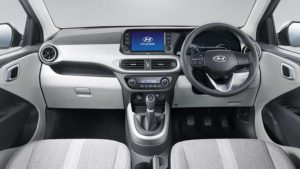The second-generation model in the form of the revolutionary Grand i10 has been a much larger achievement — it was much more comfortable, more premium and came with a diesel engine choice. Now there’s a third-generation version, and it’s bigger and includes a longer name also. Dubbed the Grand i10 Nios, this newfound version builds on the strengths of its predecessors to keep the legacy going.
The brand new car carries forward recognizable engine choices — the 1.2-liter petrol and 1.2 petrol, and with the former being BS6 compliant. What’s new is that, as well as the 5-speed guide, now you can have an automated manual transmission (AMT) alternative on both engines. Costs for the petrol-manual range between Rs 5 lakh and Rs 7.14 lakh, while those for the diesel-manual are involving Rs 6.70 lakh and Rs 7.99 lakh (ex-showroom, Delhi). The petrol-AMT is priced Rs 53,000-60,000 higher than the manual variants, although there is just one diesel-AMT version available from the higher-mid spec, priced at Rs 7.85 lakh. With such a broad price range between versions, the Grand i10 Nios is targeted at bringing a broader base of clients than before. Can it?
After our very first drive of this all-new Grand i10 Nios, we came away amazed and impressed the i10 has developed to a mature, more superior plus a more contemporary proposal. Now we have put all four variations through a full-blown road test to inform you in more detail how great this latest hatchback is.
Hyundai Grand i10 Nios Design
Contents
The Grand i10 Nios is now longer, wider and even includes a 25mm longer wheelbase compared to second-generation Grand i10. In reality, the body uses a high percentage (65 percent) of lighter yet more rigid Advanced High Strength Steel (AHSS) and higher Strength Steel (HSS), and the overall curb weight is 50-65kg lesser.

Hyundai Grand i10 NIos
The design is the evolution of the incoming car and the shape remains largely unchanged, but almost all body panels are new. The projector headlamps are sleeker and look more premium, while the oversized cascading grille, with boomerang-shaped DRLs at each end, looks distinctive. Gone are the clean lines on the bonnet and the sides, and also income some creases that include a bit more aggression and muscle to the styling. The blacked-out C-pillars provide a floating roof-like overall look and the’Gi10′ logo embossed on it is a neat detail. The diamond-cut 15-inch alloys fill the wheel arches and look nicely proportioned about the car’s overall dimensions. The back styling with new wraparound tail-lamps and different personality lines on the boot bear some resemblance with the Tata Tiago and Ford Figo. In general, the Nios is a smart-looking, contemporary hatchback.
Hyundai Grand i10 Nios Interior
We’ve seen Hyundai moving away from traditional interior designs with their current launches, and the Nios is a fine illustration of this. Its dashboard design surely stands outside, with a clean design and a big 8.0-inch touchscreen carrying the center stage. An intriguing design element is a piano-black panel which extends out of the touchscreen into the instrument cluster, which makes it resemble a large, only unit. The part-digital tool cluster has an analog tachometer that seems fantastic, and the 5.3-inch display offers lots of information. The new steering wheel has all the telephone- and also infotainment-related controls on the left spoke, but the right talked is bare, alerting you of those features Hyundai could have included (like cruise control) but didn’t. The panel over the glovebox, which has a honeycomb pattern, feels superior and looks trendy. All in all, the quality of materials used from the cabin is very impressive and the fit-finish levels are top-notch, like what we’ve come to expect from Hyundai.
The tall stance liberates good vertical space and, with its light-grey motif, there is a good awareness of space inside the cabin. The cloth seats are comfy and the cushioning is on stage; although some may find the lumbar support a bit excessive. And those with broader body frames might find the front seats for a little narrow. Like the Grand i10, even the Nios misses out on adjustable head restraints for front seats.
There are plenty of storage spaces in the cottage to keep knick-knacks, such as a well-sized glovebox, above which sits a usable open pit, cupholders, and space for a large smartphone in front of the gear console. Even the door pockets are quite accommodating and can hold one-liter bottles easily. The Nios’ 260-liter boot is adequate for a weekend getaway, and the low boot ensures loading heavy freight is quite easy.
Hyundai Grand i10 Nios Performance
What matters to most buyers is gas efficiency and that is where the Nios excels. Despite being a BS6 device, the petrol-manual Nios is significantly more efficient compared to the petrol-manual Grand i10 from the city, and it produces 13kpl, compared to Grand i10’s 11.7kpl; its highway efficacy of 16.21kpl is equal to the Grand i10’s. The news just gets better with the petrol-AMT Nios which travels 13.76km from the city and 16.61kilometers on the highway on a single liter of gas. A reason for the AMT being so efficient is its clever shift logic, and its ancient upshifting nature — for instance, that the Nios is currently in fifth gear at 45kph. The diesel-manual, nevertheless, is very striking in the range, providing 14.90kpl from the city and 19.64kpl on the highway. Following it tightly is your AMT which attained 14.87kpl in town and 19.36kpl on the street.
Powering the petrol Nios is your recognizable 1,197cc, a four-cylinder unit which has now been made BS6 compliant. Hyundai claims to have enhanced thermal efficiency and made alterations to the varying valve timing, thus reducing frictional losses to improve performance as well as refinement. But, Hyundai hasn’t managed to conceal that peculiar thrum that filters into the cabin and the vibrations sensed at the steering wheel.
Once on the move though, the engine feels extremely smooth and elegant, and solid insulation is quite good. What is nice is that petrol responds well to a part throttle inputs and it’ll keep up with visitors so long as you aren’t in a hurry; so as a point A to B commuter, the Nios does its job rather efficiently. Power delivery is optional but is not easy and has distinctive steps. The motor receives on the boil when the tacho needle goes past 2,500revs. Enthusiastic drivers will find themselves revving the guts out of the engine asking for longer, but they aren’t going to get anything more than a small set of performance figures.
The manual transmission is your recognizable slick-shifting 5-speed unit paired with a light clutch, and this also makes driving around a rather stress-free task. Another transmission is a 5-speed automated manual transmission (AMT), for which Hyundai has awakened the more expensive and inefficient 4-speed torque converter automatic that did duty on the Grand i10. Sure, it doesn’t quite match the smoothness of the torque converter, but as far as AMTs go, it’s among the best out there. The typical’head-nod’ while transitioning from first to second gear remains existing, but then, the shifts are smooth and less abrupt. The transmission’s creep purpose is quite progressive and it makes driving in bumper-to-bumper traffic smooth and simple. And that goes for the mountain starts too. The Nios rolls back a tad bit before the crawl kicks in and holds you in position. You also get a way to change gears manually, but it is ideal to leave it in auto mode to enjoy the advantages of this transmission.
At a time when producers are steering away from diesel, Hyundai continues to provide its three-cylinder, U2 CRDi engine which makes 75hp and 190Nm of torque. When cruising in a steady 100kph, the engine is turning at 2,500rpm, with only a faint thrum from the motor. So while it’s an able cruiser, it is from the town where this motor excels with almost negligible lag. Its strong bottom-end and mid-range, coupled with well-judged gear ratios, ensures that there’s considerable performance on tap whilst ambling around the city; and these also make it rather effortless to drive around without demanding continuous gearshifts. The petrol’s powerband, however, tapers drastically beyond 3,500rpm, and the engine sounds rough and feels strained in the last 1,200revs. This lack of top-end performance ends in an idle 0-100kph period of 14.54sec, which is over a second slower than the diesel Swift. Together with the slick 5-speed manual, there is currently an automatic or AMT alternative, making this the first sub-Rs 10-lakh Hyundai to receive a diesel-automatic mix. The shift features of this unit are like the petrol-AMT’s, no matter how the first few gear changes are slightly jerky, using a relatively long pause between shifts. Needless to say, in case you rush the gearbox, you would be disappointed because the diesel-AMT is the slowest of the range when it comes to outright functionality.
Hyundai Grand i10 Nios Infotainment System
New 8.0-inch touchscreen is slick and user-friendly. What is nice is that you will find buttons on both sides of the screen for quick access to several menus. Unlike the incoming Grand i10, there is no inbuilt satellite navigation system on offer, but it does get Android Auto and Apple CarPlay and they include navigation apps, among other things. The sound system is tuned by Arkamys also it sounds fine in isolation. The audio quality, however, isn’t as crisp as some of its rivals.

Hyundai Grand i10 Nios Interior
Verdict
There is a reason why the Grand i10 sold in these large numbers in India. It’d almost everything that buyers were searching for — ease of driving, smooth and elegant engines, high-quality interiors and a long features list — and this multi-faceted creation, the Grand i10 Nios, just builds on these present strengths. The Nios’ interiors are much more polished and superior, and its features list is much more expansive. Both its motors are extremely tasteful and the petrol unit is currently BS6-compliant. When it comes to real-life fuel efficiency, the Nios moves with flying colors. The option of a manual and an AMT with either engine further expands its appeal, and it’s still very user-friendly thanks to its light controls, agreeable cabin ergonomics, and good all-round visibility. Hyundai’s widespread support community will only work as a catalyst for its sales. It might not be engaging to drive, and a top-spec AMT version is sorely missed from the range, but look at it in the broader light, and you’ll see that the Nios is indeed well packaged and its principles are so sorted, it’s as good as a city-friendly, the household hatchback is.
